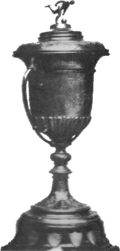 The trophy awarded to champions | |
| Organiser(s) | |
|---|---|
| Founded | 1905 |
| Abolished | 1920 |
| Region | Montevideo, Uruguay |
| Related competitions | Copa Honor (Arg) Copa Honor (Uru) |
| Last champions | |
| Most championships | (4 titles) |
The Copa de Honor Cusenier was an international football club competition which was played 13 times between representatives of the Argentina and Uruguay associations between 1905 and 1920.